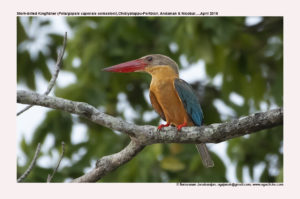
Stork-billed Kingfisher Pelargopsis capensis osmastoni
Etymology:
- Pelargopsis: Greek word pelargos – stork; opsis –appearance
- Capensis : From Cape of Good Hope, South Africa
- Osmastoni : Named after Bertram Beresford Osmaston (1868-1961) British colonial administrator
Vernacular Names: Hindi: Bada kilkila, Badami kourilla, U.P.: Badami kourilla, Mirshikars: Tunnak, M.P: Bada kilkila, Ben: Gurial, Guj: Dhonkchanch kalkaliyo, Ta: Kukuluppan, Mal: Kakka ponman, Kandu taleya meenchulli, Sinh: Wattura anduwa, Maha pilihuduwa, Mar: Balakchoch Khandya/ Dhivar
Distribution in India: Wide spread Resident in Central and East India, Andaman and Nicobar and Western Ghats.
Description: Size of 35 cm, wing length is 155 mm. It is a large kingfisher with huge bill. Both sexes of nominate race have olive-brown head, whitish chin, buff neck and underparts; upperparts dark green-blue, wings and tail bluer, rump azure; bill scarlet, darker at tip; iris dark brown; legs and feet orange-red. The juvenile has narrow dusky edges to feathers of breast and hindneck. Race Osmastoni is paler than nominate and smaller with mean wing length in male 147 mm, versus 155 mm in nominate.
Habitat: It is found in lowland waterside habitats such as the forested edges of streams, canals, large rivers, reservoirs, lakes and seashores. It is also found in primary rainforest, swamp-forest, bamboo-forest and mangroves, but also in more open areas such as coconut plantations and paddy fields; often seen perched on mangrove roots on seashore. It is found from Seashore up to 870 m.
Food Habits: It eats marine and freshwater fish, crabs and other crustaceans, but also takes frogs, lizards, rodents, young birds, also insects and insect larvae. It perches quietly on stilt roots in mangroves or on branch overhanging water, above the water, watching for prey and occasionally bobbing head or wagging tail; sits vertically, with bill inclined at 40° below horizontal; plunges down at steep angle into water or on to land to capture prey, which is then taken back to the perch and banged against branch a few times to immobilize it, before being swallowed. It follows foraging smooth-coated otters and catching prey items disturbed by them.
Breeding Habits: They breed in Jan-Sept in India. The nest is excavated in a riverbank, or decayed tree trunk, or ground or arboreal termitarium. Both sexes dig nest-tunnel that is 9–10 cm wide, up to 1 m long, ending in nest-chamber 23 cm in diameter and 13 cm high .They lay a clutch 2-5 eggs. The female parent incubates. The fledging period is 40 days. Both sexes feed the young.